Jun 19, 2009
Asteroid hazard in the context of technological development
Posted by Alexei Turchin in category: asteroid/comet impacts
Asteroid hazard in the context of technological development
It is easy to notice that the direct risks of collisions with asteroids decreases with technological development. First, they (or, exactly, our estimation of risks) decrease due to more accurate measurement of them — that is, at the expense of more accurate detection of dangerous asteroids and measurements of their orbits we could finally find that the real chance of impact is 0 in the next 100 year. (If, however, will be confirmed the assumption that we live during the episode of comet bombardment, the assessment of risk would increase 100 times to the background.) Second, it decreases due to an increase in our ability to reject asteroids.
On the other hand, the impact of falling asteroids become larger with time — not only because the population density increases, but also because the growing connectedness of the world system, resulting in that damage in one place can spread across the globe. In other words, although the probability of collisions is reducing, the indirect risks associated with the asteroid danger is increasing.
The main indirect risks are:
A) The destruction of hazardous industries in the place of the fall — for example, nuclear power plant. The entire mass of the station in such a case would evaporated and the release of radiation would be higher than in Chernobyl. In addition, there may be additional nuclear reactions because of sudden compression of the station when it is struck by asteroid. Yet the chances of a direct hit of an asteroid in the nuclear plants are small, but they grow with the growing number of stations.
B) There is a risk that even a small group of meteors, moving a specific angle in a certain place in the earth’s surface could lead to lunch of the system for the Prevention of rocket attacks and lead to an accidental nuclear war. Similar consequences could have a small air explosion of an asteroid (a few meters in size). The first option is more likely for developed superpowers system of warning (but which has flaws or unsecured areas in their ABM system, as in the Russian Federation), while the second — for the regional nuclear powers (like India and Pakistan, North Korea, etc.) which are not able to track missiles by radars, but could react to a single explosion.
C) The technology to drive asteroids in the future will create a hypothetical possibility to direct asteroids not only from Earth, but also on it. And even if there will be accidental impact of the asteroid, there will be talks about that it was sent on purpose. Yet hardly anyone will be sent to Earth asteroids, because such action can easily be detected, the accuracy is low and it need to be prepared for decades before event.
D) Deviations of hazardous asteroids will require the creation of space weapons, which could be nuclear, laser or kinetic. Such weapons could be used against the Earth or the spacecrafts of an opponent. Although the risk of applying it against the ground is small, it still creates more potential damage than the falling asteroids.
E) The destruction of the asteroid with nuclear explosion would lead to an increase in its affecting power at the expense of its fragments – to the greater number of blasts over a larger area, as well as the radioactive contamination of debris.
Modern technological means give possibility to move only relatively small asteroids, which are not global threat. The real danger is black comets in size of several kilometers which are moving on elongated elliptical orbits at high speeds. However, in the future, space can be quickly and cheaply explored through self-replicating robots based on nanoteh. This will help to create huge radio telescopes in space to detect dangerous bodies in the solar system. In addition, it is enough to plant one self-replicating microrobot on the asteroid, to multiply it and then it could break the asteroid on parts or build engines that will change its orbit. Nanotehnology will help us to create self-sustaining human settlements on the Moon and other celestial bodies. This suggests that the problem of asteroid hazard will in a few decades be outdated.
Thus, the problem of preventing collisions of the Earth with asteroids in the coming decades can only be a diversion of resources from the global risks:
First, because we are still not able to change orbits of those objects which actually can lead to the complete extinction of humanity.
Secondly, by the time (or shortly thereafter), when the nuclear missile system for destruction of asteroids will be created, it will be obsolete, because nanotech can quickly and cheaply harness the solar system by the middle of 21 century, and may, before .
And third, because such system at time when Earth is divided into warring states will be weapon in the event of war.
And fourthly, because the probability of extinction of humanity as a result of the fall of an asteroid in a narrow period of time when the system of deviation of the asteroids will be deployed, but powerful, nanotechnology is not yet established, is very small. This time period may be equal to 20 years, say from 2030 — until 2050, and the chances of falling bodies of 10 km size during this time, even if we assume that we live in a period comet bombardment, when the intensity is 100 times higher — is at 1 to 15 000 (based on an average frequency of the fall of bodies every 30 million years). Moreover, given the dynamics, we can reject the indeed dangerous objects only at the end of this period, and perhaps even later, as larger the asteroid, the more extensive and long-term project for its deviation is required. Although 1 to 15 000 is still unacceptable high risk, it is commensurate with the risk of the use of space weapons against the Earth.
In the fifth, anti-asteroid protection diverts attention from other global issues, the limited human attention and financial resources. This is due to the fact that the asteroid danger is very easy for understanding — it is easy to imagine, it is easy to calculate the probabilities and it is clear to the public. And there is no doubt of its reality, and there are clear ways for protection. (e.g. the probability of volcanic disaster comparable to the asteroid impact by various estimates, is from 5 to 20 times higher at the same level of energy – but we have no idea how it can be prevented.) So it differs from other risks that are difficult to imagine, that are impossible quantify, but which may mean the probability of complete extinction of tens of percent. These are the risks of AI, biotech, nanotech and nuclear weapons.
In the sixth, when talking about relatively small bodies like Apophis, it may be cheaper to evacuate the area of the fall than to deviate the asteroid. A likely the area of the impact will be ocean.
But I did not call to abandon antiasterod protection, because we first need to find out whether we live in the comet bombardment period. In this case, the probability of falling 1 km body in the next 100 years is equal to 6 %. (Based on data on the hypothetical fall in the last 10 000 years, like a comet Klovis http://en.wikipedia.org/wiki/Younger_Dryas_impact_event , traces of which can be 500 000 in the craters of similar entities called Carolina Bays http://en.wikipedia.org/wiki/Carolina_bays crater, and around New Zealand in 1443 http://en.wikipedia.org/wiki/Mahuika_crater and others 2 impacts in last 5 000 years , see works of http://en.wikipedia.org/wiki/Holocene_Impact_Working_Group ). We must first give power to the monitoring of dark comets and analysis of fresh craters.









